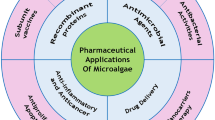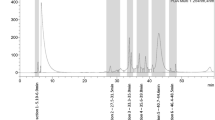Abstract
Purpose
Cancer disease is the second cause of death in the world. Now a days, high percentage of drugs, which are involved in treatment of cancers, have natural origin. Introduction of microalgae strains as anti-cancer drugs origin is a valuable approach for cancer therapy.
Methods
In the present study we describe the isolation, characterization, and anti-proliferative activity of a new microalga strain (Picochlorum sp. RCC486) from Iran. The cytotoxic activity of four different algal extracts including methanol, ethyl acetate, chloroform, and hexane were evaluated against MDA-MB-231, MCF-7, Hep-G2, and A-549 cell liens. Cell viability was determined using MTT assay in both monolayer and spheroids 3D cultures. The apoptosis was confirmed by different methods such as AO/EB and Annexin V-FITC/PI double staining, caspase-3 colorimetric assay, ROS and MMP assay.
Results
The results of MTT assay and fluorescent double staining confirmed that methanol and ethyl acetate extracts showed the best cytotoxic activity against the cancer cell lines. The production of ROS, caspase-3 activity and depolarized MMP were quite significant in MDA-MB-231 cell line treated with methanol and ethyl acetate extracts.
Conclusion
In this research we revealed that cytotoxicity and apoptotic effects of the methanol and ethyl acetate extracts in human cancer cells make them good candidates for further pharmacological studies to discover effective drugs for cancer therapy.

The present study describes the isolation, characterization, and anti-proliferative activity of different extracts of a new microalga strain (Picochlorum sp. RCC486) from Iran. The antiproliferative and apoptosis inducing activity of ethyl acetate and methanol extracts with high content of phenol and carotenoid make them as good candidates for further pharmacological studies to discover effective drugs for cancer therapy.







Similar content being viewed by others
References
Sharif N, Munir N, Saleem F, Aslam F, Naz S. Prolific anticancer bioactivity of algal extracts (Review). A J DDT. 2014;1(2):060–72.
Mohammadi-Khanaposhtani M, Safavi M, Sabourian R, Mahdavi M, Pordeli M, Saeedi M, et al. Design, synthesis, in vitro cytotoxic activity evaluation, and apoptosis-induction study of new 9(10H)-acridinone-1,2,3-triazoles. Mol Divers. 2015;19(4):787–95.
Rahmani-Nezhad S, Safavi M, Pordeli M, Ardestani SK, Khosravani L, Pourshojaei Y, et al. Synthesis, in vitro cytotoxicity and apoptosis inducing study of 2-aryl-3-nitro-2H-chromene derivatives as potent anti-breast cancer agents. Eur J Med Chem. 2014;86:562–9.
Wong RS. Apoptosis in cancer: from pathogenesis to treatment. J Exp Clin Cancer Res. 2011;30:87.
Boopathy SN, Kathiresan K. Anticancer drugs from marine Flora: an overview. J Oncol. 2010;2010:214186.
Shen HM, Liu ZG. JNK signaling pathway is a key modulator in cell death mediated by reactive oxygen and nitrogen species. Free Radic Biol Med. 2006;40(6):928–39.
Zhang R, Humphreys I, Sahu RP, Shi Y, Srivastava SK. In vitro and in vivo induction of apoptosis by capsaicin in pancreatic cancer cells is mediated through ROS generation and mitochondrial death pathway. Apoptosis. 2008;13(12):1465–78.
Circu ML, Aw TY. Reactive oxygen species, cellular redox systems and apoptosis. Free Radic Biol Med. 2010;48(6):749–62.
de Sâ Junior PL, Câmara DAD, Porcacchia AS, Fonseca PMM, Jorge SD, Araldi RP, et al. The roles of ROS in cancer heterogeneity and therapy. Oxidative Med Cell Longev. 2017;2017:2467940.
Dyshlovoy SA, Honecker F. Marine compounds and cancer: where do we stand? Mar Drugs. 2015;13(9):5657–65.
Rico M, González AG, Santana-Casiano M, González-Dávila M, Pérez-Almeida M, Tangil MS. Production of primary and secondary metabolites using algae. Prospects and Challenges in Algal Biotechnology. 2017:311–26.
Yusof YA, Saad SM, Makpol S, Shamaan NA, Ngah WZ. Hot water extract of Chlorella vulgaris induced DNA damage and apoptosis. Clinics (Sao Paulo). 2010;65(12):1371–7.
Sathasivam R, Ki J. A review of the biological activities of microalgal carotenoids and their potential use in healthcare and cosmetic industries. Mar Drugs. 2018;16(1):26.
Lichtenthaler HK, Buschmann C. Chlorophylls and carotenoids: measurement and characterization by UV-VIS spectroscopy. In: Wrolstad RE (ed) Current protocols in food analytical chemistry(CPFA). 2001; John Wiley and Sons, New York, pp F43.1–8.
Pereira H, Custódio L, Rodrigues MJ, de Sousa CB, Oliveira M, Barreira L, et al. Biological activities and chemical composition of Methanolic extracts of selected autochthonous microalgae strains from the Red Sea. Mar Drugs. 2015;13(6):3531–49.
Breslin S, O’Driscoll L. Three-dimensional cell culture: the missing link in drug discovery. Drug Discov Today. 2013;18(5–6):240–9.
Sirenko O, Mitlo T, Hesley J, Luke S, Owens W, Cromwell EF. High-content assays for characterizing the viability and morphology of 3D Cancer spheroid cultures. Assay Drug Dev Technol. 2015;13(7):402–14.
Wu LC, Ho JA, Shieh MC, Lu IW. Antioxidant and Antiproliferative activities of Spirulina and Chlorella water extracts. J Agric Food Chem. 2005;53(10):4207–12.
Cha KH, koo SY, Lee DU. Antiproliferative effects of carotenoids extracted from Chlorella ellipsoidea and Chlorella vulgaris on human Colon Cancer cells. J Agric Food Chem. 2008;56(22):10521–6.
Eghbaliferiz S, Iranshahi M. Prooxidant activity of polyphenols, Flavonoids,Anthocyanins and carotenoids: updated review of mechanisms and catalyzing metals. Phytother Res. 2016;30(9):1379–91.
Saeidinia S, Abdollahi M. Antioxidants: friends or foe in prevention or treatment of cancer: the debate of the century. Toxicol Appl Pharmacol. 2013;271(1):49–63.
Saeidinia S, Abdollahi M. Toxicological and pharmacological concerns on oxidative stress and related diseases. Toxicol Appl Pharmacol. 2013;273(3):442–55.
Tannock IF, Rotin D. Acid pH in tumors and its potential for therapeutic exploitation. Cancer Res. 1989;49(16):4373–84.
Hadi SM, Asad SF, Singh S, Ahmad A. Putative mechanism for anticancer and apoptosis-inducing properties of plant-derived polyphenolic compounds. IUBMB Life. 2000;50(3):167–71.
Abdollahi M, Shetab-Boushehri SV. Is it right to look for anti-cancer drugs amongst compounds having antioxidant effect? Daru. 2012;20(1):61.
Young AJ, Lowe GM. Antioxidant and prooxidant properties of carotenoids. Arch Biochem Biophys. 2001;385(1):20–7.
Reddivari L, Vanamala J, Chintharlapalli S, Safe HS, Miller JC. Anthocyanin fraction from potato extracts is cytotoxic to prostate cancer cells through activation of caspase dependent and caspase-independent pathways. Carcinogenesis. 2007;28(10):2227–35.
Palozza P, Serini S, Torsello A, Di Nicuolo F, Maggiano N, Ranelletti FO, et al. Mechanism of activation of caspase Cascade during β-carotene-induced apoptosis in human tumor cells. Nutr Cancer. 2003;47(1):76–87.
Fresco P, Borges F, Marques MP, Diniz C. The anticancer properties of dietary polyphenols and its relation with apoptosis. Curr Pharm Des. 2010;16(1):114–34.
Pangestuti R, Kim SK. Biological activities and health benefit effects of natural pigments derived from marine algae. J Funct Foods. 2011;3(4):255–66.
Kim YS, Li XF, Kang KH, Ryu B, Kim SK. Stigmasterol isolated from marine microalgae Navicula incerta induces apoptosis in human hepatoma HepG2 cells. BMB Rep. 2014;47(8):433–8.
Umemura K, Yanase K, Suzuki M, Okutani A, Yamori T, Andoh T. Inhibition of DNA topoisomerases I and II, and growth inhibition of human cancer cell lines by a marine microalgal polysaccharide. Biochem Pharmacol. 2003;66(3):481–7.
Acknowledgements
This work has been supported by the Center for International Scientific Studies & Collaboration (CISSC) and the National Institute for Medical Research Development Grant No. 940609. We also thanks to Professor Nasrin Moazami for her kind assistance in providing the strain.
Funding
This work has been supported by the Center for International Scientific Studies & Collaboration (CISSC) (Grant No. 1465) and the National Institute for Medical Research Development (Grant No. 940609).
Author information
Authors and Affiliations
Corresponding author
Ethics declarations
Conflict of interest
The authors declare that they have no conflict of interest.
Ethical approval
Not applicable. This article does not contain any studies with human participants or animals performed by any of the authors.
Electronic supplementary material
ESM 1
(DOCX 229 kb)
Rights and permissions
About this article
Cite this article
Abolhasani, M.H., Safavi, M., Goodarzi, M.T. et al. Identification and anti-cancer activity in 2D and 3D cell culture evaluation of an Iranian isolated marine microalgae Picochlorum sp. RCC486. DARU J Pharm Sci 26, 105–116 (2018). https://doi.org/10.1007/s40199-018-0213-5
Received:
Accepted:
Published:
Issue Date:
DOI: https://doi.org/10.1007/s40199-018-0213-5




